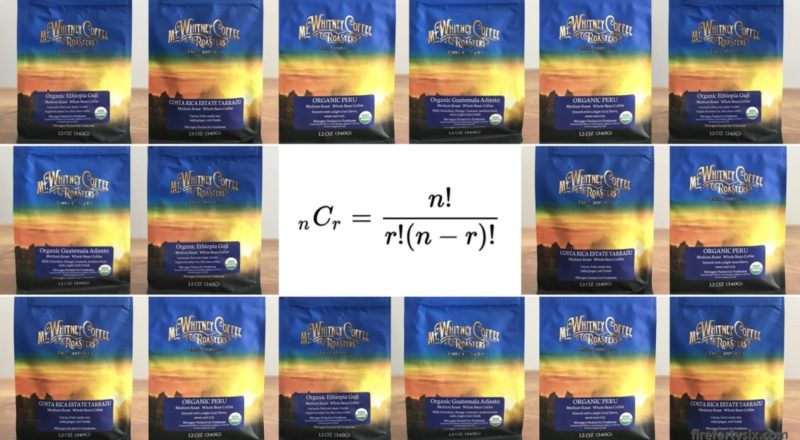Ever since I started taking my pour over coffee seriously, I’ve only been brewing single-origin beans and it has been interesting to note how taste profiles change across different regions. After the (aborted) blind taste-test experiment on The Wife using four individual single-origin beans, I still had quite a bit left behind from each bag.

It was natural to start wondering what would happen if I mixed different beans to make a blended cup of coffee: “Would the flavours clash and make a bad cup? Would they complement each other and result in an even better cup? How should I blend them to find out?”
To answer the last question, I decided to use equal amounts of each bean and try all possible combinations. But first, I had to figure out if I had enough beans to complete the entire exercise.
I whipped out the trusty combination formula to calculate the total number of unique blends I would get when mixing two, three and four different beans together.

Plugging numbers into the formula, I got a total of 11 different combinations after adding up 4C4, 4C3 and 4C2 and given my daily dose of 25gm, I would need a total of 275gm of beans, or about 69gm of each origin. Since I had close to 100gm remaining in each bag, it was more than sufficient.
Bet you never thought that making coffee would involve the use of factorials!
Yes, yes, I know. I didn’t really need to use the formula given such a small number of sets and objects, but it was the first thing that came to mind and I just ran with it.
The results would be rated using the totally scientific scale of: (i) grinning face with big eyes ????, (ii) neutral face ????, (iii) frowning face ☹️ and — for the best of the lot — (iv) star-struck face ????. What each means should be fairly self-explanatory, because emoji.
Even though each of the beans were dialed-in previously with different grind settings and brew temperatures, I decided to consistently go with 3-6-0 on my 1Zpresso JX-Pro grinder and 94°C water throughout the exercise.
Houston, we are go for launch.
I was half-expecting that the blend of all four would taste weird and confusing, but it turned out well-balanced, pleasant and kicked things off on a positive note. Like a Nestle fruit-and-nut chocolate bar, but in coffee form.
| Ethiopia | Peru | Costa Rica | Guatemala | Result |
|---|---|---|---|---|
| ✅ | ✅ | ✅ | ✅ | ???? |
The three-bean blends turned out to be a bit of a mixed bag (haha, mixed bag) with a strange tasting cup from the Ethiopia + Peru + Costa Rica, but a very nice cup was produced when the Costa Rica was swapped out and replaced with the Guatemala. The remaining two combos were just meh.
| Ethiopia | Peru | Costa Rica | Guatemala | Result |
|---|---|---|---|---|
| ✅ | ✅ | ✅ | ☹️ | |
| ✅ | ✅ | ✅ | ???? | |
| ✅ | ✅ | ✅ | ???? | |
| ✅ | ✅ | ✅ | ???? |
Blending two different beans also resulted in a wide range of outcomes, with good tasting cups arising from Ethiopia + Peru and Peru + Guatemala but a bad tasting one from Peru + Costa Rica.
| Ethiopia | Peru | Costa Rica | Guatemala | Result |
|---|---|---|---|---|
| ✅ | ✅ | ???? | ||
| ✅ | ✅ | ???? | ||
| ✅ | ✅ | ???? | ||
| ✅ | ✅ | ☹️ | ||
| ✅ | ✅ | ???? | ||
| ✅ | ✅ | ???? |
What was the conclusion from this fun exercise? Frankly, looking through all the results, I have no idea. But it was an interesting way to use up the remaining beans from my previous fun exercise.
I was kind of hoping that one of the combinations would produce a 9-point cup of coffee, but alas it didn’t. So, I guess it’s back to brewing single-origin beans and exploring different local roasters.
